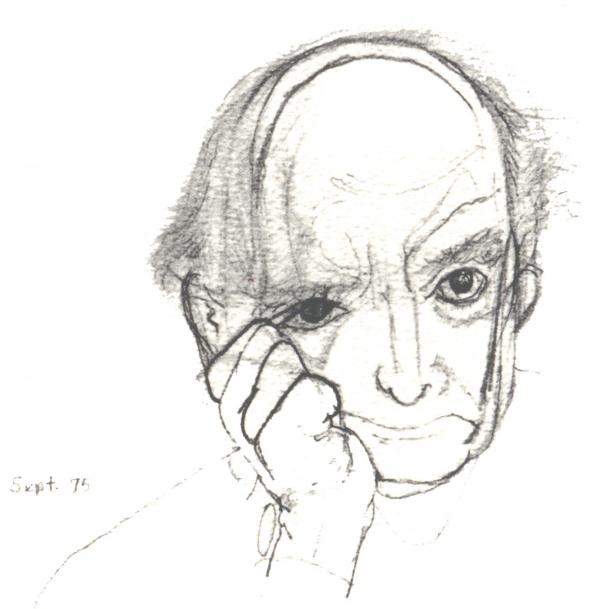
We live with a plethora of “epidemics” — obesity, diabetes, autism, prostate cancer, breast cancer, HIV/AIDS, child abuse, crime, and terrorism, to name a few. Among this multiplication of catastrophes, reports about a proliferating -epidemic of Alzheimer disease are increasingly conspicuous in the media. In his book The Longevity Revolution, Robert Butler, gerontologist, psychiatrist, and Pulitzer Prize winner, argues that one of the triumphs of the 20th century has been the dramatic increase in the numbers of people who live to old age, but he quickly adds that this has brought about an increase in the number of individuals suffering from dementia. “Unless we find ways to prevent or cure Alzheimer’s and other severe dementing diseases,” Butler argues, “the world will shortly be confronted with …the epidemic of the 21st century.” Extrapolating from this undeniable association of aging and dementia, it would appear that the ever-increasing proportion of elderly individuals in the world constitutes a burgeoning pandemic with the potential of bringing the global economy to its knees.
Since the condition was first formally named as a disease in 1908, repeated efforts have been made to delineate with ever more accuracy the clinical and neuropathological features of Alzheimer’s, with the ultimate objective of finding a cure. However, despite many billions of dollars poured into research over the past several decades, no cure has been found, and, at present, only four drugs are available by prescription that variably alleviate symptoms for a period of some months, often with side effects, and by no means in all patients.
It is perhaps not surprising, then, given the projected increase in the numbers of people who will become demented in the coming years that a move is under way in the Alzheimer world to implement research designed to bring about the prevention of this devastating condition. This new orientation is facilitated by biomedical technologies developed relatively recently expressly designed to detect molecular changes regarded as incipient signs of Alzheimer disease (AD) in the bodies of individuals. On the basis of the results of clinical trials with human populations, these technologies are in the process of being standardized, with the expectation that they will be put to use in clinical care in the coming years. The objective is to predict what the future may have in store for any one of us as we age and, ideally, to develop drugs that nip the very beginnings of AD in the bud, long before the behavioral changes associated with dementia appear.
Yet while the majority of researchers have long assumed that certain specific molecular changes revealed at autopsy are evidence of “the” cause of this condition, this hypothesis has never been proven. An increasing number of experts express skepticism about this theory today, although few, if any, dismiss the significance of the molecular changes outright.
But an increasing number argue that the situation is more complex than heretofore was believed to be the case, particularly because it is has been demonstrated repeatedly that one can harbor AD pathology in the brain but exhibit no outward signs of dementia. Alzheimer’s is an elusive mobile target in which brain and mind are not necessarily in sync.
Predictions by Alzheimer’s disease advocacy groups of the pending catastrophe can confound attempts to grapple with the problem.
When Alzheimer’s was first named as a disease in the early years of the 20th century, it was removed from the catchall pejorative category of insanity and classified as a neurological condition intimately associated with aging. But, even so, the undeniable symptoms of “senility” continued to be thought of as part of “normal” aging by the majority of the medical profession and the public alike, and remained hidden and managed as a family matter.
It was not until the 1970s that Alzheimer’s in elderly people was recognized in the medical world as a disease, first in Europe, North America, and Japan, and then later in many other parts of the world. This recognition has resulted in extensive destigmatization of the condition worldwide and is slowly reducing the abandonment and abuse that so many elderly and demented people today continue to endure.
This has been one of the objectives of Alzheimer advocacy groups since their inception in the 1970s; originally, the primary goal was to have Alzheimer’s recognized as a bona fide medical condition that should be treated, and not simply dismissed as senility, and hence regarded as an unavoidable part of aging. In order to achieve this objective, together with activist families, the newly formed AD societies in the United Kingdom and the United States worked to have dementia medicalized, in the expectation that government funding would then be set aside to support research, drug development, and the creation of facilities for care.
Despite its clinical recognition, Alzheimer’s has not been thought of as a major health care priority until very recently — no doubt due in large part to the very stigma and denial that the AD societies sought to overcome — and funding has always lagged far behind that allotted by governments and donated by the public to cures for cancer and heart disease. As the neurogeneticist Peter St George-Hyslop puts it, “Alzheimer’s is not that sexy.” It’s not “hot like breast cancer or HIV,” and lobbying efforts fall short when “affected people cannot speak for themselves.” In the United Kingdom, for example, it is estimated that until recently for every £1 spent on dementia research, £12 went to investigating cancer.
However, in the past few years it appears that the concerted efforts of medical professionals, AD societies, and the media to make Alzheimer’s more publically visible as a condition that demands immediate attention for economic, social, and humanitarian reasons are beginning to pay off. It is increasingly hard to ignore the numbers reiterated again and again in the media about the rapid increase in the near future of demented, dependent people worldwide who may well contribute to the partial derailing of whole economies. The first World Alzheimer’s Day took place on September 21, 2010, accompanied by the publication of a World Alzheimer’s Report containing damning figures, and over the past few years Alzheimer’s walks, bike rides, and marathons have been instituted in Europe, North America, and Asia.
It is through such activities that direct associations are made in the minds of health policy-makers and economic advisors alike about links among the devastating effects of the experience of Alzheimer’s on individuals and families; a rapidly changing global demography increasingly populated by the elderly, many of whom are eligible for pensions; and the economic impact on families, the workforce, and productivity, particularly in an era of general economic decline.
Even though an accurate assessment of “so-called” AD cases is simply not possible at either national or international levels, when we read about Alzheimer’s in the media and in publications put out by AD advocacy organizations, the estimated number of cases and predictions about the pending catastrophe are reported with great assurance. This mobilization of numbers without doubt has a political effect, but it muddies the waters when attempting to come to grips with what exactly constitutes Alzheimer’s disease and how best to confront it.

The current disputations surrounding the research in AD (the findings are very unlikely to bring about closure any time soon) will have direct consequences for individuals, families, policy making, and future research directions, as we strive to contain the “epidemic” of the 21st century. Despite the undeniable complexity and associated uncertainties encountered in the research, hope must be sustained if funding is to keep flowing. Overly optimistic estimates about a cure for AD are no longer tenable; even so, the U.S. government announced in 2012 that it was increasing its funding for AD as part of a bid to “prevent and effectively treat Alzheimer’s disease by 2025.”
The expectation is that diagnoses of presymptomatic dementia will be made routinely in clinics wherever -governments can afford it, or when insurance companies are willing to pay. Before too long, we may all be required to engage in what could well be thought of as 21st-century divinatory practices in an attempt to avert our respective destinies. The key signifiers of the future will no longer be cracked turtle plastrons or heated ox, sheep, or deer shoulder bones — the tools made use of in the I Ching — but rather molecular substances known as “biomarkers,” inscriptions (as Bruno Latour would put it) of changes concealed in the body assumed to signify future events.
Based on individual biomarker testing, many thousands of people will be expected to submit themselves to intense medical surveillance to detect signs of progression from presymptomatic dementia to mild cognitive impairment detectable in the clinic, and then to early Alzheimer disease. This move, if it comes to fruition, has the potential to become the biggest screening program with global reach ever established, at untold expense to health care systems. It will quite possibly have problems similar to those associated with the screening programs designed to detect breast and prostate cancer, in which estimations of individual risk and decisions about the appropriate course of action to take based on these estimates have proven highly problematic in all but certain high-risk cases.
These divinatory practices are likely to create a highly potent zone of anxiety about what may be in store in the future for individuals and their family members. Having bodily signs of apparent medical significance uncovered and named by experts would, one might assume, bring about greater insight into the future than do fables told by fortune-tellers. However, paradoxically, the more we learn about the world of molecular biology, a characteristic feature of all forms of divination persists — namely, that in seeking to take control of the unknown, new ambiguities, anxieties, and uncertainties inevitably come to the fore.
A great deal remains to be explained, and if drug failures continue to plague the field, then the amyloid hypothesis that is the core of the current approach must be severely modified or dropped entirely, as even those researchers who are the most committed to a molecular approach now concede. A move under way to pay closer attention to cell loss, the significance of which has always been thought of as secondary due to the attention given to plaques and tangles, may rather rapidly bring about some modification of the cascade hypothesis. Paradoxically, biomarker findings have been a major reason for deeper investigation into the onset and significance of cell loss, including the finding that some individuals can apparently adapt to such a loss better than others.
Not only is there still a very long way to go in pinning down the molecularized universe of AD-like dementias, half the story continues to be barely recognized and researched. The question of what it is that protects so many individuals from dementia even at a great age, including many of those who are assumed to be at risk due to their genetic heritage, has rarely been examined systematically.
This issue, noted in passing by so many researchers, foregrounds the manner in which the biology of aging itself is embedded in social, political, and economic matters. The politics of AD research has been, above all else, to emphasize the horror of dementia, and its unwanted repercussions on the economy, in order first and foremost to raise money for research to cure the disease. Although healthy lifestyles are promoted by AD societies and other organizations dealing with the elderly, the vital question about what it is that raises the odds of having a dementia-free old age is nevertheless marginalized.
The heterogeneity of Alzheimer’s ensures that there is no silver bullet for the disease.
In order to assess why and how so many individuals remain healthy and active even in old age, a move must be made away from AD causation conceptualized as in the brain alone, to include variables mediated by the boundary-traversing mind, such as education, traumatic social and familial events, social isolation, deprivation, and so on, and, in addition, variables that affect neurodevelopment directly, including exposure to toxins, prions, other disease-causing entities, inadequate diet, and others. If the AD “epidemic” is to be confronted, a public health approach orchestrated at global and local levels is called for, one that targets variables than can readily be manipulated without resort to expensive technologies, high-powered facilities, and highly trained personnel. This, surely, is the most humanitarian and effective way to approach the problem, one that does not, of course, rule out support of a well-funded research program designed to tackle the molecular puzzles that are so challenging.
Although those who work to increase funding for AD wish to sustain a frightening image of the global future ravaged by an unstoppable AD epidemic, the reality is that there will be no silver bullet for Alzheimer disease — the heterogeneity of the condition that so many researchers surely recognize ensures that this will be so. The challenge presented by an aging brain exceeds that posed by all other organs of the body.
Even so, perhaps it will be expedient to retain an overarching AD category for political purposes — the AD label would be used as a heuristic device, a good-enough category, designed to keep societies and governments focused on the enormity of the problem. If and when AD is systematically broken down into subtypes, knowledge about this fine-tuning will filter out into the public domain without necessarily reducing the symbolic power of AD as a tragedy that must be countered by every possible means, including concerted research efforts, outstanding clinical care, and improved family support.
The hype associated with the current “shake-up” in the AD world may lead people in wealthy countries to believe that at last we are on track for a cure. But every indication is that we should not hold our breath in light of the persistent failure of drug trials. The work of Thomas McKeown showed that during the long interim in which scientists were struggling to develop antibiotics in the early part of the 20th century, improved nutrition and -hygiene brought about a major increase in longevity due to a substantial drop in infectious diseases, long before drugs were available. We would do well to keep this in mind — breakthroughs in big science take time, and with a “pandemic” of aging fast approaching, as we are led to believe, a great deal can be done relatively simply to alleviate the situation through improved care of and social support for the elderly, particularly when individuals become dependent and frail.
The current move to prevention in the AD world by means of surveillance of biomarkers is presently for research purposes alone, in the hope of eventually bringing drugs to market. In the unlikely event that these technologies are approved for clinical use, drugs developed, and their prescription routinized, most elderly people in the world will not have access to them unless enormous social and political changes first take place — a highly unlikely scenario. And facilities will most certainly not be available for the majority of individuals, regardless of where they live, to have AD biomarkers regularly monitored from middle-age on.
As the memories and minds of these individuals decline with age, a large number may well continue to be thought of merely as mad, senile, or -simply old and faded. Their burden on meager health care systems and local economies will not be that great, although families will indeed be bur-dened, with the result that large numbers of elderly may well be subjected to neglect and even starvation. Such lives may count for little, except possibly to boost global statistics designed to normalize the approaching pandemic of aging, and very occasionally such individuals will be of use as research subjects.
To improve the lot of this vast majority, therefore, a globally orchestrated political shift to the implementation of public health programs is urgently needed, one that is not ultimately driven by a molecularized approach to AD. This approach would be designed to engage with the reality of aging while attempting to reduce dementia prevalence, or at least slow its progression, no doubt largely through the agency of family and communities that receive governmental support. Such a move would also reduce the stigma that continues to be associated with dementia in so many places.
But a public health approach such as this, essential though it is, can have only a limited effect. It is clear that, equally important, the contribution to AD incidence of contemporary global politics must be explicitly acknowledged and, if at all possible, acted upon. Alleviation of poverty and chronic inequalities and universal access to good nutrition, sanitation, and education have long been recognized as crucial to human health; the situation today is somewhat improved in some parts of the world, but for millions this is not the case. The forcible removal of hundreds of people from arable land and their relocation, ever-increasing polluted environments, and numerous other harmful stresses exerted on huge swaths of the world’s population due to the demands of endless capital accumulation are increasingly toxic. While these conditions persist and increase, Alzheimer incidence will not be reduced. Nor will the incidence of many other illnesses, several of which, including diabetes and obesity, contribute directly to dementia.
One further reality must be kept in mind: no amount of preventive measures and no drug will defeat aging (even though certain maverick scientists are attempting just this), nor can dementia be “wiped out” as though it is an infectious disease. Aging and dementia cannot be disentangled. All we can strive for is to find ways to stave off or halt the progression of AD, at whatever age it strikes.
This is an adapted excerpt from Margaret Lock, The Alzheimer Conundrum: Entanglements of Dementia and Aging. Copyright © 2013 by Princeton University Press. Reprinted by permission.
Photo: Shutterstock






